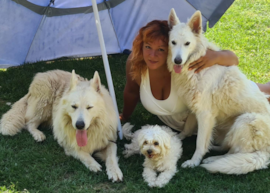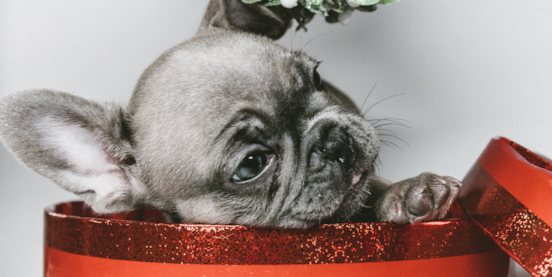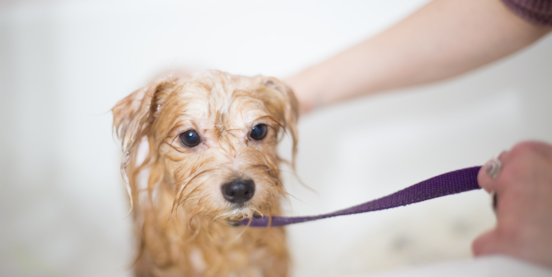Premier Pups > Breed Insights > How to Train a Puppy
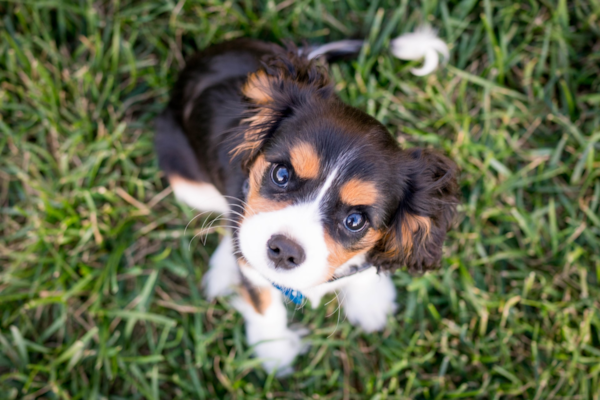
Published Friday, August 20, 2021 by Elena R.
“My dog’s not spoiled, I’m just well-trained”
Puppies are goofy and adorable, and they have a great deal of love to give, there is no denying that. Their tiny paws, little tails, button noses, and expressive puppy-dog eyes often translate to cuteness overload and that’s enough to tame even the wildest of hearts.
Once a puppy arrives at his forever home, his puppy instincts will tell him to explore the premises like an investigator, show off his designer skills by remodeling the furniture, and chew everything he can get his paws on. More often than not, pet parents will let their new puppies have their cute little ways without correcting any potentially destructive behavior.
They explore, chew, eat, play, sleep, and repeat. That’s all puppies know how to do and unless we teach them more, they can become unruly and turn into stubborn adult dogs later on.
Puppies don’t understand words until you teach them what they mean. They associate words with actions. This means that you can use words like “sit”, “pilot the plane”, or “funny bunny” to teach them to sit and they won’t know any different.
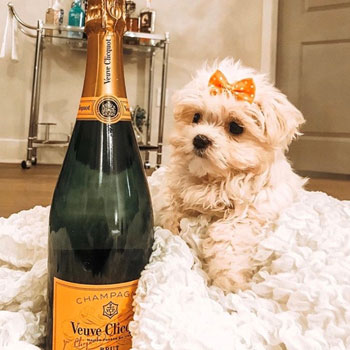
Table of Contents
- Training a puppy requires patience and persistence
- Positive reinforcement methods give the best results when training a puppy
- Start training your new puppy early on
- Training your puppy to come when called
- Puppy potty training
- Training your puppy to walk on a leash
- Training your puppy to sit
- Training your puppy to lie down
- Training your puppy to wait
- Socializing your new puppy
- Crate training your puppy
- Training your puppy to be independent
- Training your puppy – tips and tricks
Training a puppy is perhaps one of the most important tasks a pet parent must undertake
If you decide to adopt a puppy, you need to be prepared for a long-term commitment that involves regular training. Training your puppy is important for both you and him. It’s a rewarding experience on both ends and a great bonding opportunity. A well-trained puppy will grow up to be a well-behaved, obedient, and happy dog and that makes all the difference in the world.
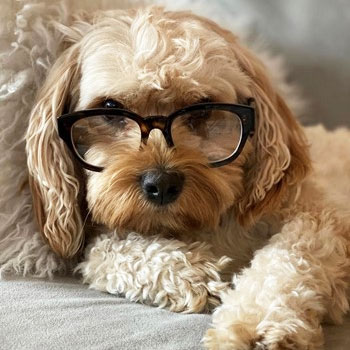
Training a puppy requires patience and persistence
Puppies have short attention spans. They much prefer to play with their puppy toys and explore under the couch rather than sit quietly and wait for commands. They are unruly, excited, and rebellious. This means that you need to find fun and creative ways to keep them focused and eager to learn.
Patience is key when training a puppy and you must keep at it even if you don’t see fast results. Training your puppy will always pay off. Some puppies are obedient by nature while others are more stubborn. In either case, it’s best to keep training sessions brief and fun and have lots of treats at hand. 5 to 10 minutes of training twice a day will do the trick for most puppies.
Positive reinforcement methods give the best results when training a puppy
Puppies love to be praised, cuddled, and applauded, and they enjoy delicious treats just as much as we do. They have favorite toys, puppy treats, and favorite praise words. Using training methods that include positive reinforcement, lots of praise, petting, treat-based/reward motivation, dog toy motivation, food lure, encouragement, and a gentle tone of voice will bring the best results. All of these methods will ensure that both you and your puppy will have a great time teaching/learning.
When training a puppy, it’s never a good idea to use violence, threats, a harsh tone of voice, or punishments. Your puppy will become confused, and possibly scared, and will not likely respond in any positive manner.
It is also not recommended to push boundaries during training. If your puppy looks uncomfortable, bored, or tired, it is best to end the training session and pick it up at a later time.
Start training your new puppy early on
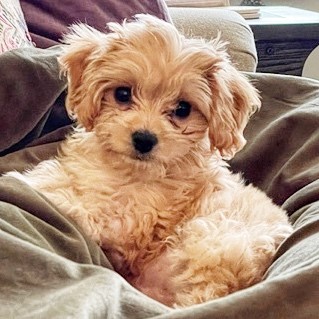
Puppies are smart and capable of learning basic commands early on. The best time to start the training process is around 8 weeks old. It is believed that 8-week-old puppies can pick up on the tone of your voice and body language without any prior training and they can understand quickly what they are and aren’t supposed to do (whether they act on it or not is a completely different story). Training your new puppy early will give him the mental stimulation he needs and will help him develop into a healthy, well-rounded, happy adult dog.
Don’t wait too long before you start training your puppy. Puppies pick up on everything very early on. Training them incorrectly or not teaching them that some behaviors are wrong, or certain things are off-limits, will prove to be harder to undo or fix later on. 8-week-old puppies are easier to train than 5-month-old puppies and waiting too long can lead to difficulty in training or a missed window of opportunity.
Untrained puppies often grow up to be stubborn dogs who will want to “fight” to establish dominance. If you don’t feel like bending the knee for your little k9 warrior, then it’s best to start the training process the moment you adopt your new puppy.
Training your puppy to come when called
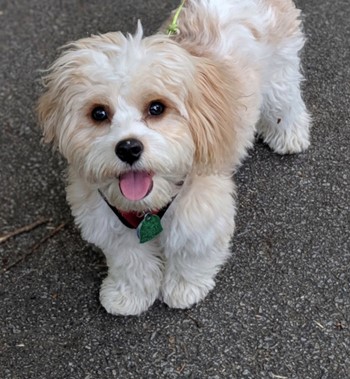
Having your puppy come to you when called is the first training lesson he or she should receive. This training lesson should be kept in a quiet environment. Puppies are new to the world and they will want to explore everything around them. They will want to check out what’s under your bed, what you’re hiding in your purse, and where you keep your shoes. That being said, it’s important to designate a quiet area indoors where there are no distractions to start training your puppy.
The first thing you will want to do is call out your puppy’s name followed by a recall word of your choosing (e.g. Come) and give them a delicious treat when they reach you. Repeat this as much as possible throughout the day for fast results. Your puppy will be eager to come when called knowing there is a special puppy treat waiting on the other end.
Once your puppy gets used to his recall word and comes without hesitation, you can move on to an area with more and more distractions until they pose no problems. It’s also best to transition from treats to praise in recall when you are comfortable with your puppy being out into the world and responding to you regardless of distractions.
Puppy recall training should be practiced frequently over a few months and in several areas for the best results.
Puppy potty training
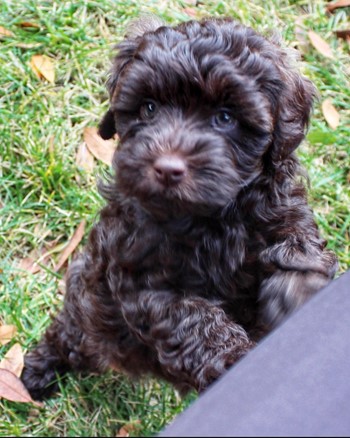
Young puppies go when they need to go regardless of the “where”. They don’t generally seek out your expensive rug or shoes but rather do their business where they feel like it. Potty training should start when the puppy is at least 10 weeks old.
Puppies have tiny little bladders, which means they can’t exactly “hold it in”. It is recommended to start potty training using puppy pads. Take your puppy to the pad as soon as they wake up, finish eating, have an active play session, and before they go to sleep. Once they do their business on the pad, make sure to reward them with a delicious puppy treat. Repeat this reward method each time your puppy goes to potty on the pad. Once your puppy gets accustomed to the pad, take the pad outside with you on walks and lay it down for your puppy to use.
Treat your puppy to a delicious reward whenever he uses the pad outdoors. As soon as your puppy gets used to doing his business outdoors, remove the pad, and keep the rewards coming for a little while longer until you replace them with praise. Going potty outside will become second nature to your puppy and no treats or praise will become necessary later on.
Training your puppy to walk on a leash
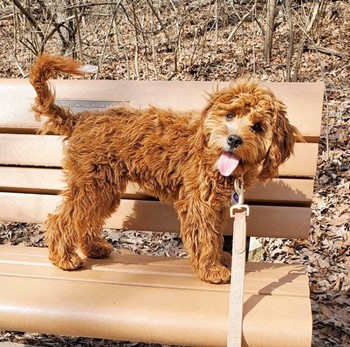
You can start leash training your puppy as early as 8 weeks. Keep in mind that young puppies are teething and will possibly try to chew the life out of a leash. That being said, the best way to accustom your puppy to the leash is to first introduce it as a simple object that casually lies around his space. That way he will get used to it without any difficulty. During this time, place the collar around his neck and leave it there for a little while (puppies tend to forget they have something around their necks) until he gets used to it.
Once your puppy is comfortable with the collar and around the leash, attach the leash to the collar and make a fun game out of walking around the living room. Make sure to treat your puppy to a delicious reward when he walks calmly near you and doesn’t try to bite off the leash. He will learn to heel and walk on a leash at the same time.
Once your puppy has all of his puppy vaccinations up to date, you can take him outdoors and practice leash walking and heeling around distractions. Always make sure to reward your puppy for good behavior during every training session. When your puppy has mastered leash walking with a collar on, you can trade the collar for a puppy harness.
Training your puppy to sit
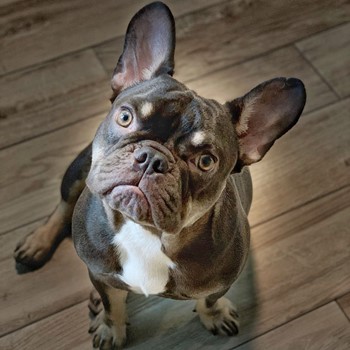
Training your puppy to sit is one of the easiest lessons you can teach. With this trick, identifying the right moment is key. Puppies tend to learn faster when they want or are excited about something. You can start this lesson when your puppy is eager to play with his favorite toy, craves one of his puppy treats, or is excited about going out for a walk.
All you have to do is simply take a delicious treat (or his favorite toy), hold it between two fingers above your puppy’s nose, and gently move your hand toward your puppy’s head. Choose your action word (e.g. Sit) and say it as you move the treat above his nose. Trying to reach the treat, your puppy will naturally sit down. Once he sits, give him the treat and some well-deserved praise. Repeat this lesson regularly and in various places around the house and outdoors. It will teach your puppy to obey everywhere.
It is important not to repeat your action word, but rather be patient and wait for your puppy to execute his command. If you tell your puppy to sit multiple times before he has the chance to, he will learn that it is okay for him to not obey the first time he hears his command, or you will end up having to say “Sit, sit, sit, for the love of dog SIT” every time you want your puppy to sit.
Training your puppy to lie down
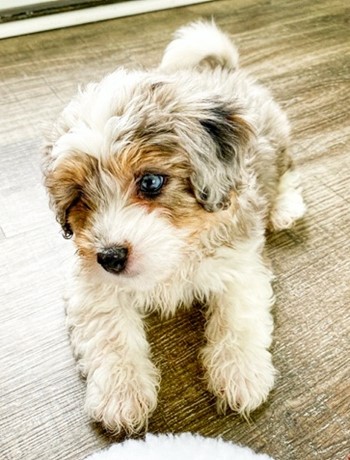
Training your puppy to lie down is very similar to training him to sit. The first thing you need to do is have your puppy sit and once he is in the sitting position, take a treat, let him see it, and slowly move your hand close to the ground. Always start this command with your puppy in the sitting position. Your puppy will try to get up at first and take the treat while standing. When this happens, do not give him the puppy treat, but rather ask him to sit and try again. When your puppy is getting into his down position, say your action word, and give him his well-deserved treat. Repeat this command frequently and make sure to transition off of puppy treats once he gets used to performing the task.
Never force your puppy physically to sit or lie down. This will only be counterproductive and very confusing for your puppy as he will not understand what is being asked of him.
The importance of transitioning between treats, praise, and pets, is that you teach your puppy to follow commands or perform tricks even when there is no reward for doing so. These commands will become second nature to them, and they will no longer seek to receive treats when doing what is asked of them.
Training your puppy to wait
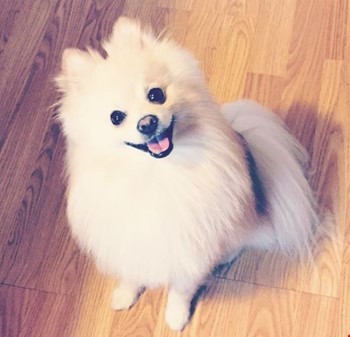
Puppies are excited and enthusiastic little beings. They rarely sit long in one place, and they are not exactly known to be patient. Training them to wait is sure to be a funny and fun activity for both of you. For this trick, you will need a puppy toy, preferably a squeaky dog toy, or your puppy’s favorite treat. This command should be taught in a quiet low-distraction area to begin with.
Training your puppy to wait should be done with him in the sitting, or lie-down position. Once your puppy is sitting, say your command word (e.g. Wait), then wait a few seconds and give him the treat or dog toy. Make sure that he doesn’t get up or lunge at you to get the toy or treat between the time you say your command and the time you give him the treat.
Repeat this lesson regularly and gradually increase the time between command and reward. Once you have increased the time to at least a 10-second wait, take a step backward from your puppy, say the command, wait a few seconds, return near your puppy, and reward him for waiting with praise and his dog toy or treat. This exercise aims to keep him waiting patiently while you gradually take more steps away from him.
Socializing your new puppy
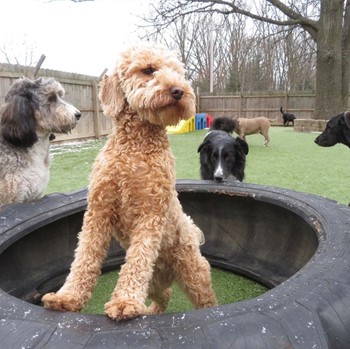
Socializing is one of the most important training lessons a puppy can receive. It will ensure that a puppy is well-mannered around children, other dogs, and pets and it will help them avoid social anxiety when met with new places, or strangers. Puppies are naturally social and open to meeting new people, and it is essential they remain that way. Introducing your puppy to new sounds, distractions, new people, places, experiences, other dogs, and pets early on is one of the most important aspects of puppyhood training.
Puppy socialization generally begins at 8 weeks and ends at around 12 weeks. By 12 weeks a puppy should be socialized and comfortable around other people, and dogs.
Starting socialization training after 12 weeks will prove to be difficult and your puppy may be shy or cautious around strangers, or even frightened by cars, sounds, and new places.
Gradually introduce your new puppy to people and dogs, and get him familiar with the area around your block and neighborhood. Make sure your puppy is comfortable being around traffic and new faces, and try to make the experience as fun as possible. You can also enroll your puppy in puppy kindergarten and puppy school where he can make new friends and socialize with other puppy “students”.
Crate training your puppy
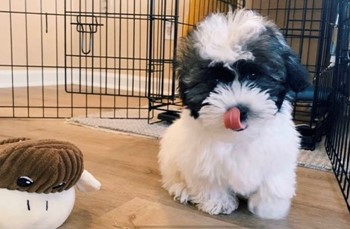
Puppies and dogs need to have a canine sanctuary of their own. They seek out safe places where no one can “reach” them. Whether it’s a crate, a drawer in your closet, or a spot under your couch your puppy will find a place to call his (and only his) home. That being said, dog crates are highly beneficial for both puppies and their pet parents. They offer a haven for dogs and give pet parents more control. Teaching your new puppy to be comfortable in a crate is similar to training him to wait.
When you bring your puppy home, move his crate into your room, close to your bed. Sit down beside him and give him treats while the crate door is open and he is inside. Once he appears to be comfortable with the crate, move on to closing the door and proceed to reward your puppy with delicious treats. Sit by his closed crate for a few minutes and then take a step backward and reward him again. Gradually increase the steps and continue with rewarding him until you exit the room completely.
You mustn’t leave your puppy in a crate for hours during crate training. This will only make him dislike the crate and possibly avoid it later on. Gradually increase the time you leave your puppy in his crate until you are comfortable that you can leave him for longer periods at a time without risk. You can then move his crate to a different room and make a fun game out of it.
Training your puppy to be independent
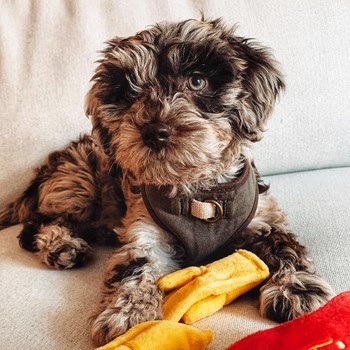
We’ve all seen those internet photos with couches torn to shreds, make-up feasts, and kitchen closets ravished by the “demolition dog” left home alone for a couple of hours. That’s more than enough to make a potential pet parent reconsider adopting a puppy. Separation anxiety is a severe condition in dogs. It manifests in destructive behavior, excessive barking, revenge chewing, and going potty everywhere. Thankfully, training a puppy to enjoy some alone time without being destructive is possible.
Puppies need to know that they are not being abandoned when you leave home and the best way to do that is to start leaving them alone for a few minutes at a time when they are very young.
Don’t try to test their limits at the get-go. They need time to adjust, and training them to be independent is a long process. You need to gradually increase the minutes you leave them alone and provide them with plenty of toys to keep busy with. Once your puppy proves to handle his alone time well, increase the minutes until you reach the amount of time you are most likely to be away from home.
Training your puppy – tips and tricks
- Be consistent. Train your puppy daily until you are completely satisfied with the results.
- Create a puppy schedule and live by it. Try to train your puppy with a daily schedule.
- Get a playpen for your puppy. You can use the puppy pen as a “schooling” area.
- Don’t repeat commands. Wait for your puppy to do what you asked him to.
- Take your pup to puppy classes, puppy school, or puppy kindergarten.
- Make sure the puppy food and puppy treats you use in training are vets recommended.
- Don’t test your puppy’s boundaries, it will only prove to be counterproductive.
- Keep training sessions short and fun.
- End the training session when your dog gets bored or tired.
- Don’t rush, training takes time.
- Keep a puppy feeding chart to make sure you don’t overfeed during training.
Scroll down to see FAQs about puppy training!
What To Read Next
Learn How To Gift A Christmas Puppy The Right Way
Christmas is just around the corner and the struggle to find loved ones the perfect gift is starting to set in. We all want to see our loved ones filled with joy when opening their presents. Some people love jewelry, others love ugly Christmas sweaters, and most... Read More
Grooming your Dog at Home Guide
Creating good grooming habits and routines for your dog at home is essential for several reasons and you don’t have to be a professional dog groomer to do it right. By doing regular grooming at home, you can help your dog look its best between visits to the... Read More
Frequently Asked Questions
What is the best age to start training a puppy? The best time to start training a puppy is around 8 weeks old. At this age, puppies can quickly pick up on the tone of your voice and body language, making it an ideal time to start the training process.
How can I potty train my puppy? Potty training should start when the puppy is at least 10 weeks old. It is recommended to start potty training using puppy pads. Once they do their business on the pad, reward them with a treat. Gradually, you can transition to outdoor potty training.
How can I train my puppy to walk on a leash? Leash training can start as early as 8 weeks. Begin by introducing the leash as a simple object around their space. Once your puppy is comfortable with the collar and leash, make a fun game out of walking around the living room. Gradually, you can practice leash walking outdoors.
How can I train my puppy to sit? Training your puppy to sit is one of the easiest lessons. Start this lesson when your puppy is eager to play or excited about something. Use a treat or their favorite toy, hold it above their nose, and gently move your hand towards their head. As they sit, give them the treat and some praise.
How can I train my puppy to lie down? Training your puppy to lie down is similar to training them to sit. Start with your puppy in the sitting position, then use a treat to guide them into a lying down position. Once they lie down, reward them with a treat.
How can I train my puppy to wait? Training your puppy to wait can be done with them in the sitting or lying down position. Say your command word (e.g., "Wait"), then wait a few seconds and give them a treat or toy. Repeat this regularly and gradually increase the time between command and reward.
How can I socialize my new puppy? Socializing is an important part of puppy training. Introduce your puppy to new sounds, people, places, and other dogs and pets early on. You can also enroll your puppy in puppy kindergarten or puppy school for further socialization.
How can I crate train my puppy? Crate training should start by making the crate a comfortable space for your puppy. Give them treats while the crate door is open and they are inside. Once they are comfortable, close the door and reward them with treats. Gradually increase the time they spend in the crate until they are comfortable being in there for longer periods.


